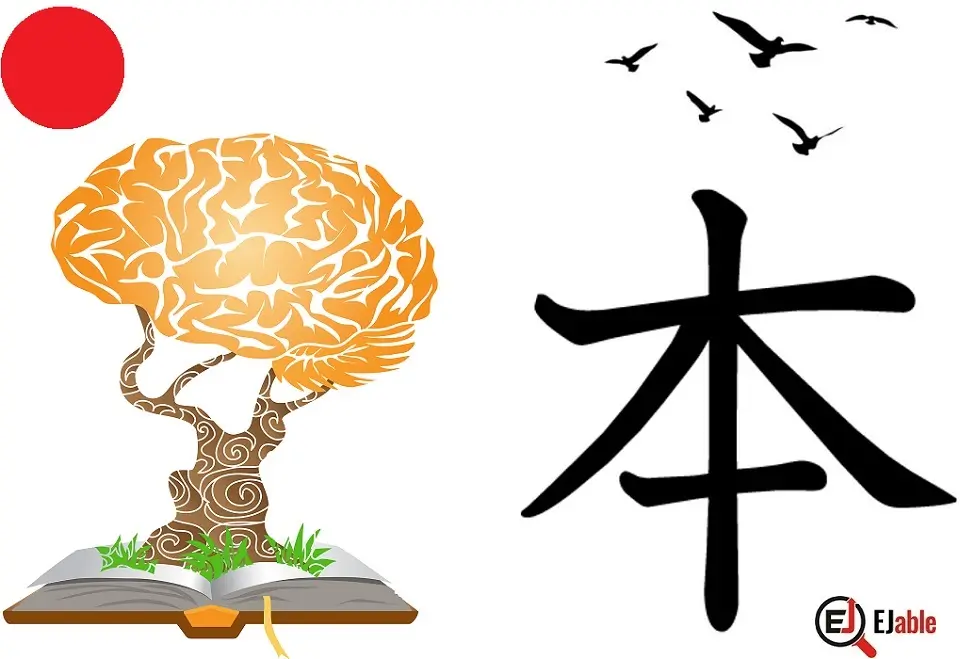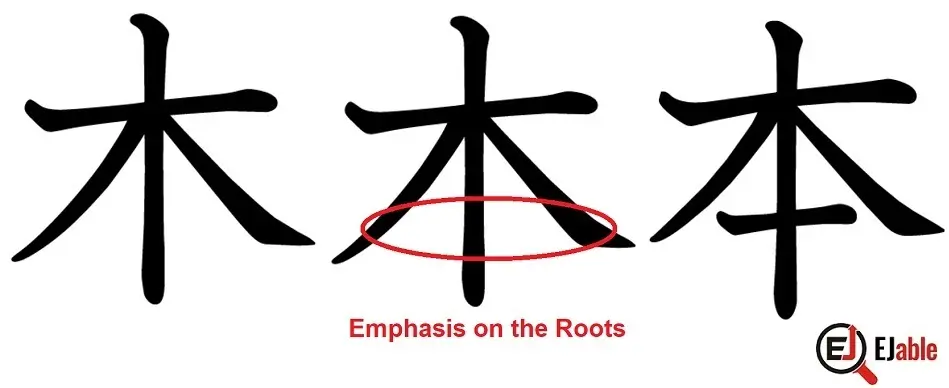Kanji for Book (本, Hon, Moto, or Pon)

The kanji for “book” is “本“. In modern usage, 本 primarily signifies “book.” However, the Kanji 本 also denotes the origin or basis of something and can also mean “origin,” “basis,” “main,” or “true,” depending on context.
The book’s Kanji is constructed with 4 strokes. It is part of the JLPT N5 syllabus (please check the list of JLPT N5 Kanji). In Japanese schools, this Kanji is taught in grade 1.
This article will discuss the origin of Kanji for “book” and easy ways to remember it. We will also discuss the radicals of this Kanji and the compounded words in which 本 appears.
Pronunciation and Other Meanings of 本
The pronunciation of 本 can be “Hon,” “Moto,” or “Pon,” depending on the context. When used independently, it’s usually pronounced as hon and means book. It can be pronounced as moto in other contexts, such as in surnames like Yamamoto (山本) or place names. In the Japanese name of Japan, i.e., Nihon or Nippon (日本), it is pronounced as “hon” or “pon.”
The above-mentioned words are some examples of the alternate, or in fact, the original meaning of the Kanji 本. Let’s check the following examples:
- Yamamoto (山本): “Base of the Mountain”
- Nihon or Nippon (日本): “Origin of the Sun”
- Honmono (本物): “real” or “genuine“
- Hongen (本源): “source” or “origin“, often used to describe the fundamental cause or root of something.
The following is the summary of the various meanings of the Kanji 本:
- Book: This is perhaps the most common usage of 本 in everyday language. For example, 本を読む (hon o yomu) means “to read a book.”
- Origin or Source: In this sense, 本 is often seen in compound words. For instance, 本 in the word 本源 (hongen), signifies “source” or “origin.”
- Main or Real: 本 can refer to the “main” or “real” thing, as opposed to a copy or imitation. For example, 本物 (honmono) means “the real thing.”
- Counter for long cylindrical things: Interestingly, 本 is also used as a counter for long, cylindrical objects, such as bottles, roads, and even movies. For instance, we use 二本ボトル (nihon botoru) means “two bottles”. Similarly, Roppongi (六本木) means “six trees”.
- Volume (of a book): In a context where a series of books is being discussed, 本 can refer to a specific volume of the series.
Origin of the Book’s Kanji 本
The Kanji 本 originates from the pictograph of a tree with roots. Please check the article about the Kanji of tree. This representation symbolizes the idea of the “origin” or “source,” which is one of the meanings of 本. It’s interesting to note that ancient books were written on thin pieces of wood, which is also symbolized in the kanji by 木 (tree).


Logic and How to Remember Kanji of Book (本)
The logic behind this Kanji, which also means “origin,” “source,” or “base.”, apart from the book, is that Books are the basis or origin or the main source of learning.
The above logic is how to remember this kanji, which is to imagine a tree with an emphasis on its roots or the base.
Check the following illustration to memorize this as a kanji for tree (木) with a highlight (emphasis) on the roots. The horizontal line at the bottom emphasizes the roots, which brings us back to the idea of “origin.”


To remember the book’s kanji, i.e., 本, think of the connection between the origin (root) of something and a book, which can provide foundational knowledge or source material on a subject.
We should also remember that when paper was first created, it was made from trees. Hence, the kanji for the book includes the kanji for tree.
This fascinating kanji beautifully encapsulates that knowledge and learning are the roots of human culture and development.
本 in Compounded Japanese Words
There are 327 Japanese words that begin with the Kanji 本, and it appears in 1040 words.
Following are some of the examples of words that include the kanji 本 (hon), which can mean “book,” “main,” “origin,” “real,” etc., depending on the context:
- 本人 (honnin): The person himself or herself
- 本物 (honmono): The real thing
- 本社 (honsha): Head office, headquarters
- 日本 (Nihon or Nippon): Japan (literally “origin of the sun“)
- 本日 (honjitsu): Today
- 本当 (hontou): Truth
- 本気 (honki): Seriousness
- 本屋 (hon’ya): Bookstore
- 本州 (Honshū): Honshu, the main island of Japan
- 本文 (honbun): Main text, body (of a letter)
- 本名 (honmyō): Real name
- 本棚 (hondana): Bookshelf
- 本来 (honrai): Originally, primarily
- 本能 (honnō): Instinct
- 本土 (hondo): Mainland, home country
Book’s Kanji as a Radical and Component
The Kanji of the book 本 does not appear as a Kanji radical in the widely recognized standard Japanese language. Such Kanji characters may be found in specialized dictionaries or historical texts; however, they are not part of the regular kanji set taught or used in contemporary Japanese.
There are 9 Kanji characters where the book’s Kanji appears as a component. Out of these, there are 2 Jōyō Kanji. These 2 Jōyō Kanji with book as a component are
One commonly used Kanji with the radical of the book’s Kanji is 体 (たい / tai, からだ / karada). The Kanji 体 means “body” or “substance”. In 体, 本 conveys an underlying sense of something fundamental or essential. The other is 鉢(ハツ / hatsu, ハチ / Hachi), which means “bowl”.
This limited usage of the Kanji for book 本 as a radical in other kanji reflects its strong, independent meaning, which doesn’t frequently lend itself to being a part of more complex kanji characters in the way that some other radicals do.
Do check other Kanji characters on the page “How to Remember Kanji“.


A long-term ex-pat in Japan, Himanshu comes with an IT background in SAP consulting, IT Business Development, and then running the country operations of an IT consulting multinational. Himanshu is the co-founder and Managing Director of ReachExt K.K. and EJable.com. He is also an Advisory Board Member of a Silicon Valley AI/IoT startup.

